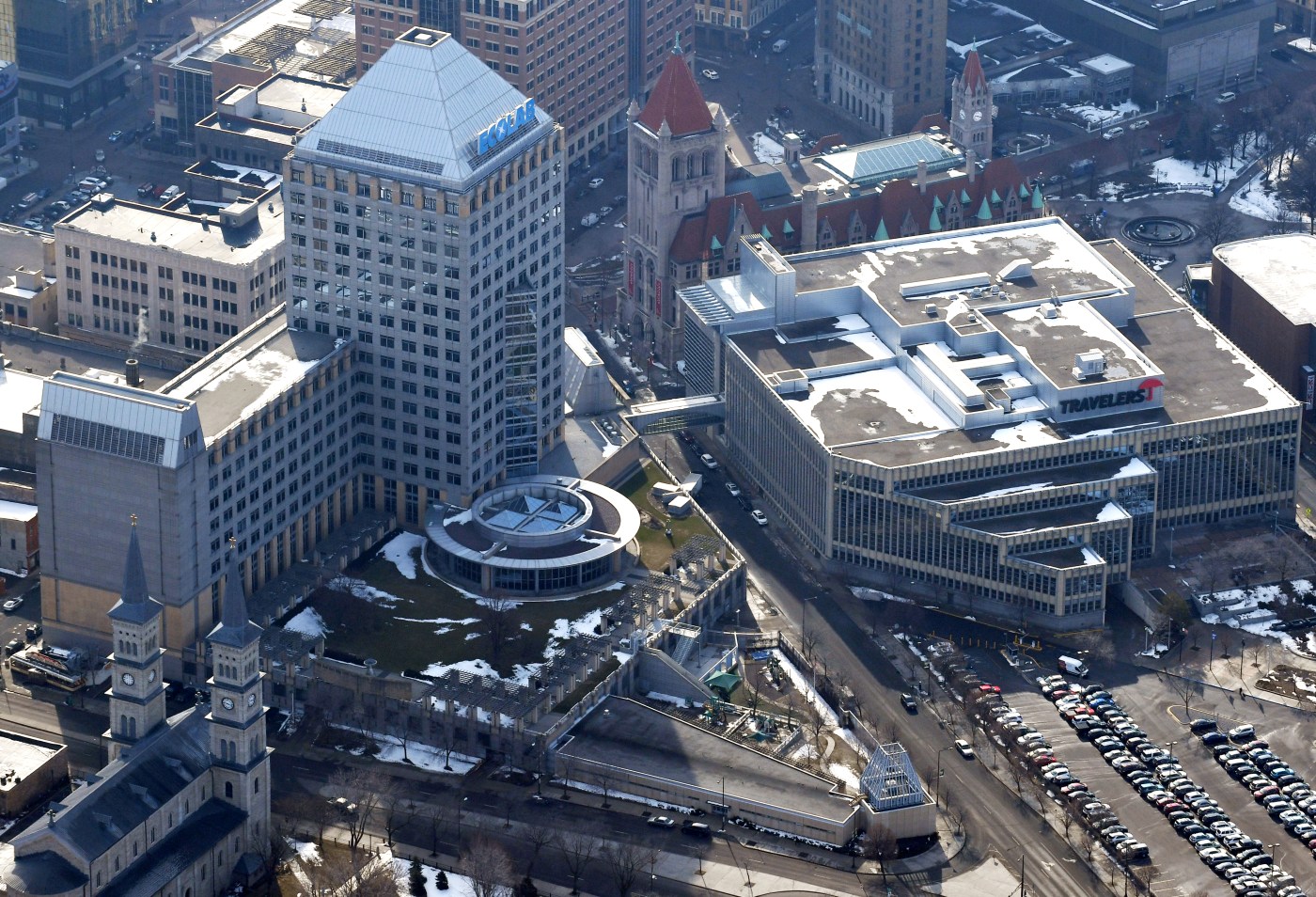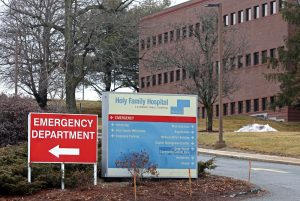
To boost downtown St. Paul, group calls for pedestrian improvements, office-to-residential conversions
After 175 years, downtown St. Paul’s storied Rice Park continues to draw visitors and special events, as does Lowertown’s popular Mears Park and nearby CHS Field.
The space in between?
Not so much. Even diehard St. Paul advocates acknowledge that Fifth Street in particular has become a bit of a dead zone dotted by dark windows and empty storefronts, a symbol of the challenges holding back the area’s potential.
“We don’t have to make every block-face amazing downtown, but we have to get these key connector streets right,” said Joe Spencer, president of the St. Paul Downtown Alliance, in a recent interview. “Rice Park is amazing and Mears Park is amazing, but there’s very few people walking between those two spots.”
Turnover among restaurants, retailers
It’s no secret that downtown St. Paul, which was already struggling with turnover among restaurants and retailers before the pandemic, has since lost some mojo. While visitors have returned to the Xcel Energy Center, overall foot traffic downtown has yet to return to pre-pandemic levels, and too many darkened corners line both ground level and skyways — which could have major impacts on city tax coffers as building valuations fall.
What could turn downtown’s fortunes around?
The St. Paul Downtown Alliance, a partnership between City Hall and major employers such as Securian and Ecolab, have released a 125-page report outlining key opportunities.
The new “Downtown Investment Strategy,” assembled with the help of New York-based planning consultants, calls for focusing on three general categories of improvements. They are:
Office-to-residential conversions
Tax incentives and other city-led efforts to promote housing and density would reduce the amount of empty, low-demand office space. That could strengthen the commercial market by providing new customers for restaurants and retail. St. Paul Mayor Melvin Carter said the city is exploring selling the annex office building across from City Hall on 4th Street and moving hundreds of city employees into leased spaces throughout privately-owned downtown office buildings.
Pedestrian-oriented streetscapes
An aesthetic makeover of a few key connector streets like Fifth Street and Kellogg Boulevard could make the experience of exploring downtown feel safer and more enjoyable, and create a better walking experience between existing hubs like Mears Park and Rice Park.
Predevelopment efforts
To boost interest and investment from the private sector, the report calls for taking “tactical, early-phase actions” to promote a handful of priority redevelopment projects, including the empty land around the Central Station light rail stop and the future Park at RiversEdge and its underlying parking ramp. The unofficial entertainment district stretching from the Xcel Energy Center to the Landmark Center could benefit from greater definition and better tie-ins to the rest of downtown. Other recommendations include further study of the skyway system, which could benefit from concentrating lunch counters and retail vendors at ground level instead of maintaining them spread throughout second-floor areas.
The report suggests closing some skyway corridors to public use entirely.
Destinations of choice
That said, the greater priority is to focus on the ground-level experience of walking along corridors like Fifth Street, Kellogg Boulevard, Wabasha Street, Robert Street and Seventh Place.
Downtowns no longer function as essential places that residents have to frequent in order to hold a job, go shopping or get a haircut. They’re now destinations of choice, and the report finds that choosing to work, visit and live downtown needs to be incentivized — in short, moving from a “Central Business District” to a “Central Social District.”
Despite dipping in 2020, residential growth downtown is on pace to reach 30,000 residents by the year 2050, though that’s too far off to be of help in the immediate future. The number of jobs downtown has been on decline since at least 2018, if not 2011. The Xcel Energy Center is once again drawing some 3 million visitors annually, but the surrounding area is 1 million visitors short of pre-pandemic activity from 2019.
The mayor’s office, hand in hand with the Downtown Alliance, set a goal last summer of growing downtown from 10,000 residents to 30,000 residents — which would total about 10% of the city’s population — even faster, while also adding enough employment downtown to account for half the jobs in the city.
“When this organization got launched, the mission was to drive vitality in downtown St. Paul,” Spencer said. “I always got asked, what does ‘vitality’ really mean? And a couple years in, we were able to say vitality means people. It means tripling the downtown population to add 20,000 residents. It means adding 20,000 jobs. We currently have 55,000 jobs. We want to grow to 75,000 jobs.”
“As we’re looking for more private capital to be invested in downtown to allow for that growth, the premise is private capital follows people,” Spencer added. “And people need great spaces, where people want to be.”
Taxes
What does the fate of downtown St. Paul mean for city tax coffers? The report notes that the stakes for everyday property owners is sizable.
Over the years, property taxes collected downtown haven’t grown as much as the city’s tax levy, leaving homeowners and small businesses citywide to pick up the difference. Commercial properties in the downtown core have lost about 10% of their value since 2021. If downtown building valuations keep falling, that could mean even higher property taxes across the board.
Rather than redraw the map, much of the goal of the new improvement strategy is to enhance downtown’s existing offerings by improving pedestrian access and adding residents and foot traffic.
“Downtown St. Paul has a wide range of assets to build upon, including regional visitor anchors, an established residential community, committed corporate leadership, and proximity to Minnesota’s State Capitol,” reads the report from James Lima Planning+Development. “It also has a relatively compact geography, with the potential to be an eminently walkable downtown, where residents and workers mix with both first-time visitors and those with season tickets for hockey or theater.”
Office-to-residential
Instead of collaborative, open office layouts popular with technology companies, downtown St. Paul has too much surplus, low-demand office space (“Class B” and “Class C”) with small floor plates left over from bygone eras. The good news, said the mayor in a recent interview, is that those small floor plates lend themselves to residential conversions into apartments.
The pace on office-to-residential conversions has slackened downtown. To give it a boost, the “Downtown Investment Strategy” finds that the city could implement key policy changes, creating a more efficient permitting process specific to downtown conversions.
In addition, Ramsey County could work with the city and state to create a tax incentive program aimed at supporting conversions. And, the city could leverage the work of the St. Paul Port Authority to create an acquisition fund and buy and repurpose buildings that the private market “critical buildings for which the private market has been unable to generate sufficient interest or commitment.”
A ‘downtown public realm framework’
Rather than attempting to beautify all of downtown at once, the report calls for prioritizing key pedestrian corridors. That includes expanding pedestrian-oriented street reconstructions by working with the state on making state roads more pedestrian-friendly, and adding branded “subdistricts” such as “the Lowertown Arts District” through signage.
The report also notes that instead of enhancing each other, the skyway and ground-level pedestrian experiences are effectively in competition. Using the city’s “Grow Downtown” initiative, the city could help skyway vendors relocate to ground level storefronts, improving access and foot traffic while freeing up space for start-up companies.
The report recommends a skyway traffic study “to determine the viability of appropriately configuring the skyway to meet current and future needs,” and it suggests the city “should work with building owners to close non-passageway portions of the skyway which are currently minimally activated, including largely vacant food courts.”
Three key redevelopment projects
The report recommends a heavy focus on three redevelopment projects in particular, with private business and other public sectors helping to lead the way.
For the private sector to take interest and move forward with redevelopment, the “risk profile seems lower when the mayor is saying the same things as a downtown CEO as the community not-for-profit advocacy organization and the philanthropic organization,” said report author James Lima, in an interview. “That is as valuable as subsidy in some cases to just signal that.”
“Unlike most cities, St. Paul didn’t create a downtown management organization until the last five years,” he added. “You’ve got some catching up to do on that front.”
To develop the long-vacant area around the downtown Central Station light rail stop, which is no stranger to crime and loitering, the city could team with the state, county or Metropolitan Council to highlight the level of public subsidy available for future developers. If that doesn’t work, the public sector could roll out its own temporary or permanent project aimed at making Central Station a more desirable area.
Ramsey County has proposed $26 million toward the Park at RiversEdge, a 9-acre downtown park that would extend off Kellogg Boulevard from a land bridge over Shepard Road and the adjacent railway to the Mississippi River shoreline. The state has committed $6 million, though the county is seeking another $20 million from state coffers.
The report finds that “other public sector partners should support the county’s efforts to secure funding to create the public infrastructure here, setting the stage for subsequent private investment.” That includes adding structured parking.
The area around the Landmark Center, the Xcel Energy Center and other cultural landmarks form an unofficial entertainment district that could be better defined to capture “a coordinated series of investments.” Those investments could include improvements to the X and the adjoining RiverCentre, a new convention center hotel, new residences and everyday attractions for people working and staying in the area. The Minnesota Wild and other private organizations could play roles in conversations with state funders, but anchor organizations first need to subscribe to the vision.
“St. Paul, collectively, must speak with one voice about the way in which the state can invest in the future of the heart of the capital city, to ensure that it is ever more welcoming to all, both day and night,” reads the report.
Related Articles
Downtown St. Paul shooting of woman may have stemmed from money dispute, police say
Weezer to kick off 30th anniversary ‘Blue Album’ tour in St. Paul
Six months after reopening, downtown St. Paul restaurant Momento is closing for good
State of the City highlights: Melvin Carter promises homebuyer assistance, street work — and a snow plowing experiment
Intimate downtown St. Paul music venue KJ’s Hideaway has abruptly closed


